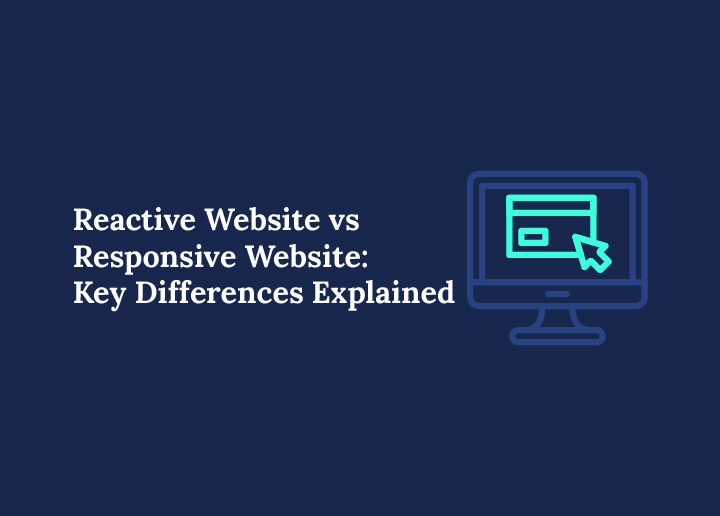Understanding the subtle yet significant differences between a reactive website and a responsive website is crucial for businesses, developers, and marketers. While both are designed to deliver a great user experience, they achieve this goal differently.
The confusion between these two approaches can lead to poor performance, frustrated users, and missed business opportunities.
This guide will demystify the concepts of reactive vs responsive website design. We will explore their core philosophies, the technologies that power them, and their distinct advantages and challenges.
By the end, you’ll clearly understand which approach best suits your specific needs, whether you’re building a simple blog or a complex, data-driven web application.
Understanding Reactive Websites: Definition, Technologies, and Benefits
At its core, a reactive website is built for dynamic, real-time user-driven experiences. Unlike a traditional website that serves static pages, a reactive site constantly updates its content in response to user interactions, data changes, or external events without needing a full page reload. This approach creates a highly personalized and interactive experience.

What is a Reactive Website?
A reactive website is a dynamic single-page application (SPA) or a part of a larger application that responds to user input and data changes in real time. It’s an architecture where the user interface (UI) automatically updates itself when the underlying data changes.
Think of a live stock ticker, a real-time chat application, or a social media feed that updates instantly as new posts appear. This reactive design creates a fluid and seamless flow of information, enhancing user engagement and providing an enjoyable user experience.
Key Technologies Behind Reactive Websites
Modern JavaScript frameworks and a sophisticated development approach power the magic behind reactive websites.
- JavaScript Frameworks: The foundation of most reactive sites is a JavaScript framework like React, Vue, or Angular. These frameworks enable developers to build complex, component-based UIs that efficiently manage and display data.
- Event-Driven Architecture: This is a programming model in which events, such as a mouse click, a keyboard press, or an external data update, determine the flow of a program.
- Asynchronous Updates: Using technologies like AJAX (Asynchronous JavaScript and XML) or modern Fetch API, a reactive website can exchange data with a server in the background without interrupting the page’s current display. This allows for partial updates and a more fluid browsing experience.
- Reactive Programming: This paradigm focuses on data streams and change propagation. It’s the technical heart of reactive design features, ensuring the UI reacts instantly to data changes.
Build a Powerful Reactive or Responsive WordPress Website Today
Get a custom WordPress website that blends reactive design interactivity with responsive layouts to deliver flawless performance across all devices.
Advantages of Reactive Websites
The reactive website approach offers several significant benefits, particularly for applications that require high levels of user interaction.
- Real-Time User Experience: The seamless, real-time feedback loop is the primary benefit. Users don’t have to wait for pages to refresh; the UI updates instantly, which is critical for tools like live dashboards or online games. This leads to an improved UX and higher user engagement.
- Scalability: Because reactive frameworks handle data updates efficiently on the client side, they can manage complex applications with a high volume of data changes without overwhelming the server with constant page requests.
- Personalized Engagement: Reactive websites excel at providing tailored content and experiences. They can dynamically change the UI based on user behavior, preferences, and real-time data, which is invaluable for modern e-commerce and media platforms.
- Potential SEO Benefits with SSR: While traditionally challenging for search engines, modern reactive web design can be optimized for SEO using Server-Side Rendering (SSR) or pre-rendering. This allows the server to deliver a fully rendered HTML page to the crawler, making the content indexable.
Challenges and Considerations for Reactive Websites
Despite their advantages, reactive websites come with their own set of challenges.
- Development Complexity: Building a reactive website is more complex than a traditional one. It requires a deep understanding of JavaScript, frameworks, and state management, making it more challenging for less experienced developers.
- Initial Load Time: A reactive website often requires the browser to download a heavier bundle of JavaScript code. This can lead to a slower initial page load, turning off some users.
- SEO Challenges: Without proper optimization techniques like SSR, search engines may struggle to crawl and index the content of a reactive site. This can negatively impact search rankings.
Understanding Responsive Websites: Definition, Technologies, and Benefits
In contrast to the dynamic nature of a reactive website, a responsive website is all about adaptability. The core philosophy of responsive web design is to provide an optimal viewing and interaction experience across a wide range of devices.

A single website codebase is designed to automatically adjust its layout, images, and content to fit the screen size of any device, whether it’s a desktop computer, tablet, or mobile phone.
What is a Responsive Website?
A responsive website uses a single set of files to serve all users, regardless of their device. The responsive layout dynamically resizes and rearranges content to ensure a clear and usable experience.
This is the most common approach to modern web design and is the standard for building mobile-friendly websites. The goal is a consistent user experience for all users, whether using a large screen or a small mobile device.
Key Technologies Behind Responsive Websites
The responsive web design approach relies on a combination of foundational web technologies.
- HTML: Provides the basic structure of the web pages.
- CSS (Cascading Style Sheets): Controls the presentation and visual styling of the content.
- CSS Media Queries: Media queries are the heart of responsive design. They are CSS rules that allow developers to apply different styles based on the characteristics of the user’s device, such as screen size, orientation, and resolution.
- Flexible Grids and Images: Responsive layouts use fluid and flexible images that resize proportionally to the browser window. This ensures that the design elements don’t break or cause horizontal scrolling.
- Viewport Meta Tag: A simple HTML tag that tells the browser to set the width of the page to the width of the device’s screen, preventing it from zooming out on mobile devices.
Advantages of Responsive Websites
Responsive web design has become the industry standard for a good reason.
- One Codebase, Easy Maintenance: You have a single website to manage, update, and maintain. This simplifies web development and reduces costs compared to managing multiple versions or a dedicated mobile site.
- Mobile-Friendly and SEO-Friendly: Google recommends responsive design as a best practice because it makes it easier for search engines to crawl and index your site. A single URL for all devices avoids issues with duplicate content and simplifies link management, which is great for search rankings.
- Wider Audience Reach: By accommodating all the most commonly used devices with one site, you ensure that you don’t alienate any segment of your audience, whether desktop or mobile.
- Consistent Experience: While it may not be as dynamic as a reactive website, a responsive site provides a consistent and predictable navigation experience across all devices.
Limitations of Responsive Websites
While highly effective, responsive websites have some limitations.
- Performance Concerns: Without careful optimization, a responsive site might load assets (like large images) intended for a desktop site on a mobile device. This can increase load times and consume more bandwidth, negatively impacting site speed and performance.
- Limited Interactivity: A responsive website is primarily concerned with adapting layouts. It’s not inherently designed for complex, real-time user interactions like a chat application or a live dashboard. While you can add some interactive elements, it’s not the core strength of this approach.
Differences Between Reactive and Responsive Websites
Choosing between a reactive and responsive website is a critical decision that impacts development, performance, and long-term business goals. Here are the key differences.
Design Philosophy and Focus
The core difference lies in the design philosophy. Reactive web design focuses on dynamic data and user input. It’s about how the UI reacts to changes in data.
Responsive design, on the other hand, is about adapting the layout to the physical dimensions of the device type. It focuses on screen sizes, not on data changes.
Performance and Loading Behavior
A responsive website typically loads the same initial HTML file for all devices, with CSS dictating the final look. If optimized correctly, this can be lightweight and fast.
However, a reactive website often loads a single, larger JavaScript bundle on the first visit. While this initial load might be heavier, subsequent interactions are lightning-fast because the UI updates without a full page reload.
User Experience and Engagement
The goal of a responsive website is a consistent, accessible experience. The navigation and content are the same, just rearranged. The goal of a reactive website is a personalized, interactive, and highly engaging experience.
Think of the difference between reading a static blog post (responsive design) and interacting with a real-time analytics dashboard (reactive design). The latter’s improved UX is its most significant selling point.
SEO and Indexing Considerations
This is one of the most critical key differences. A responsive website is inherently SEO-friendly. Since there’s only one URL and one set of files, Google’s crawlers can easily index the content. A reactive website, however, can be a challenge for search engines if not correctly configured.
If the content is loaded via JavaScript after the page loads, crawlers may not see it. This is why techniques like Server-Side Rendering (SSR) or pre-rendering are essential for a reactive web design to perform well in search rankings.
Development Complexity and Maintenance
Responsive design is more straightforward and more familiar to most web designers. It primarily uses HTML and CSS.
By contrast, reactive web design is more complex and requires specialized knowledge of JavaScript frameworks. This impacts development time, cost, and the expertise needed on the web development team.
Quick Comparison of Reactive and Responsive Websites
This table concisely overviews the core differences between reactive web design work and responsive and adaptive design. It helps web designers quickly understand how adaptive layouts, fluid grids, and CSS styles impact site performance across multiple screen sizes and desktop users.
| Aspect | Reactive Website | Responsive Website |
| Focus | Real-time interactive experience | Layout adapts to device screens |
| Technology | JavaScript frameworks, event-driven architecture | HTML, CSS, media queries |
| Performance | Optimized per interaction, heavier initial bundle | Lightweight but may load unnecessary assets |
| UX | Dynamic, personalized, high engagement | Consistent across different devices |
| SEO | SSR or pre-rendering needed | Mobile-friendly, Google-recommended |
| Development | Complex, requires expertise | Simple, easier to maintain |
Choosing Between Reactive and Responsive Websites: Use Cases
Choosing between a reactive design and a responsive design is not about which is “better” but which is “right” for your specific use case.

When to Choose a Reactive Website
Choose a reactive website for a highly interactive, data-driven, personalized experience.
- Web Applications: Live chat apps, collaborative tools, or project management platforms.
- Dashboards: Business intelligence tools, web analytics dashboards, or financial data trackers.
- Live Data Platforms: Stock market trackers, real-time sports scoreboards, or live news feeds.
- Complex Sites that need to handle a lot of user input and provide immediate feedback.
When to Choose a Responsive Website
Choose a responsive website for most standard websites where the primary goal is to present information clearly and accessibly.
- Blogs and News Sites: Content-heavy sites where the focus is on reading.
- Corporate and Informational Sites: Websites for businesses, portfolios, or non-profits that must be universally accessible.
- E-commerce Stores: While some interactive elements can be added, a standard e-commerce site primarily needs a consistent user experience across all devices.
Combining Both Approaches for Optimal Performance
A hybrid strategy is the best approach for many modern websites. You can build a core responsive layout that ensures cross-device compatibility and then layer on reactive components where dynamic user interactions are needed.
For example, a blog site might have a responsive design for its articles but use reactive design features for a live comment section, a product filter, or a real-time search bar. This combines the SEO benefits and simplicity of responsive web design with the enhanced UX of a reactive website.
Best Practices for Implementing Reactive and Responsive Websites
Whether you go all-in on reactive web design or stick with responsive web design, these practices will ensure your site is fast and effective.

Optimizing Reactive Websites for Performance and SEO
Implement strategies like server-side rendering, interactive elements, and careful use of adaptive web design techniques to enhance site performance and ensure search engines index dynamic content. Optimized reactive websites can enhance user experience while maintaining mobile and desktop compatibility.
- Server-Side Rendering (SSR): This is non-negotiable for reactive websites that want to rank well. SSR renders the initial HTML on the server, making the content available to search engines and improving the initial load time.
- Code-Splitting: Don’t load all the JavaScript at once. Use code-splitting to break down the bundle into smaller, manageable chunks only loaded when needed.
- Caching and CDN: Utilize caching mechanisms and a Content Delivery Network (CDN) to serve assets faster to users worldwide.
- Device Testing: Always test your site on mobile phones, tablets, and desktops to ensure a smooth experience.
Optimizing Responsive Websites for Speed and User Experience
Responsive websites adapt layouts to a device’s screen size using fluid grids, CSS styles, and media queries.
This approach avoids loading unnecessary assets, supports mobile-friendly websites, and ensures that adaptive and responsive design principles create an appropriate layout for users who interact on both mobile and desktop devices.
- Mobile-First Design: The best practice in responsive design is to design for mobile devices first and then scale up for larger screens. This forces you to focus on the essential content and leads to a lighter, faster experience for all users.
- Responsive Images: Use the HTML <picture> element or the srcset attribute to serve appropriately sized images to each device. This prevents mobile users from downloading large desktop site images.
- Lazy Loading: Implement lazy loading for images and other assets that are below the fold. This speeds up the initial page load time.
- Minimizing Assets: Compress and minify your CSS and JavaScript files to reduce their size.
Hybrid Strategies for Modern Websites
The hybrid approach is becoming the standard for complex sites. You can use a responsive framework like Bootstrap or Tailwind CSS to handle the core layout and a reactive framework like React for specific interactive modules.
This gives you the best of both worlds: a great baseline experience for everyone and a dynamic experience where it matters most.
Common Misconceptions About Reactive and Responsive Websites
Unlike responsive design, reactive web design focuses on dynamic, interactive elements rather than adjusting adaptive layouts for different screen sizes.
Many mistakenly think separate sites or templates are always needed. However, combining adaptive website design with responsive and adaptive design can improve UX and reduce the need for mobile versions or separate tracking.
- Reactive & responsive: This is the most common misconception. They are not interchangeable terms. Responsive design is about layout, while reactive design is about data and interaction.
- Reactive Sites are automatically SEO-friendly: As mentioned, this is false. Reactive websites require extra work (SSR) to be appropriately indexed by search engines.
- Responsive websites are always fast: This is also false. A poorly optimized responsive site that loads too many scripts or high-resolution images can be slower than a dedicated mobile site or a reactive website.
- Hybrid designs are too complex: While they require more planning, the benefits of a hybrid approach often outweigh the initial complexity, providing a more robust and future-proof solution.
Conclusion: Choosing the Right Website Approach for Your Business
Navigating the web development landscape requires a clear understanding of your goals.
Do you need a content-first, accessible site for a wide audience? Responsive web design is your ideal choice.
re you building a complex, data-driven application that needs real-time updates and high user engagement? Reactive website architecture is the way to go.
The key takeaway is that your specific use case should drive the decision. A responsive website is the practical and most effective solution for most businesses, blogs, and informational sites. For specialized web apps, a reactive website provides a superior user experience.
But remember, the future of web design lies in the hybrid approach, which combines the accessibility and SEO benefits of responsive design with the dynamic power of a reactive website, creating a truly modern and effective online presence.
FAQs About Reactive Website vs Responsive
What is adaptive web design, and how does it differ from responsive web design?
Adaptive web design uses separate templates or adaptive layouts for target devices. In contrast, responsive web design relies on fluid grids and CSS styles to adjust layouts automatically to multiple screen sizes.
How do reactive design features enhance user experience?
Reactive websites include interactive elements that respond in real-time as the user interacts, helping to enhance user experience, improve engagement, and support mobile websites and desktop users alike.
What are the best practices for optimizing mobile-friendly websites?
Use media queries, flexible images, and adaptive and responsive design principles to ensure mobile websites load efficiently, display correctly on multiple screen sizes, and maintain site performance.
Can adaptive website design and reactive web design work together?
Yes, combining adaptive website design with reactive design work allows websites to use adaptive layouts for desktop users and mobile versions while providing dynamic, interactive elements for better UX.
Do I need separate websites or templates for different devices?
Not necessarily. With adaptive and responsive design, one website can include adaptive layouts and fluid grids to adjust to a device’s screen size, avoiding separate sites while maintaining appropriate layout and tracking.



